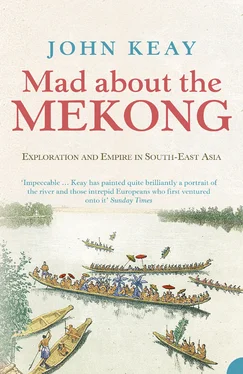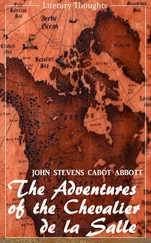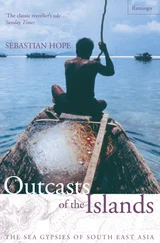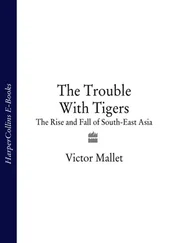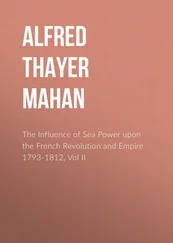But there has recently been a change. In the late 1990s border restrictions were eased, new rivercraft were introduced in Cambodia, and some controversial channel-clearance was begun on the Sino – and Lao – Burmese borders. For the first time in living memory retracing the route of the Mekong Exploration Commission became feasible, if not easy. A golden age in Mekong navigation looked to be dawning.
Sadly it could prove to be short-lived. Water conservation tops the agenda of all the riverine states, while hydro-electricity provides some of them with their main export-earner. In Chinese Yunnan the river is already dammed. So are many of its downstream tributaries; the chainsaw and the mechanical digger are everywhere gouging roads round unsuspected contours; and extant plans threaten to transform the entire hydrography. Natural forest, traditional livelihoods, and the occasionally alarming interplay of menace and innocence in this great green basin may all be swept away within the next few decades.
The rehabilitation of the river could prove its undoing. On the other hand, rehabilitating the story of its exploration may be instructive. Scarcely anywhere has been more traumatised by recent history than mainland south-east Asia. Retracing the expedition’s trail means revisiting the aftermath of more twentieth-century wars – international, civil, ‘secret’ and ethnic – than even the Balkans can boast. (The Vietnam war was the third but by no means the last.) It means circumventing the best natural forest because of the unexploded ordnance, tripping through smiling landscapes memorable for unparalleled savagery, and paddling up tranquil reaches still infamous for narco-insurgency. The experience takes the edge off unalloyed enjoyment and, for a Westerner, invites self-recrimination.
But stay the whip; for the Eden into which the Mekong Exploration Commission first blundered also fell far short of the idyllic. Slavery, banditry and the prevalence of almost every known tropical disease so appalled the Frenchmen that they seemed to justify colonial intervention. The explorers did not, though, berate the prevailing rulers, and mostly they thought well of the Buddhist establishment. They just diagnosed and prescribed. Blaming the acknowledged ills of one society, or one century, on the presumptions of another demeans them both.
It is simply the sequential nature of events, and in this case of intervention—its logic and its consequences – that may be instructive. As with the river at the heart of this story, natural obstructions and human interference contain merit as well as menace. Flooded forest provides the ideal spawning ground for fish; hillside erosion upriver guarantees alluvial abundance in the Delta; and the colonial cake-cutting urged by the expedition probably forestalled more cataclysmic strife than it created. Like fully-fledged trees being tumbled perilously through the rapids, events take their course, not easily deflected yet foreseeable as to season and direction by those who trouble to study the current and read the weather.
AN INDO-CHINA CHRONOLOGY
THE ADVENT OF THE FRENCH
| 1859 |
French naval force seizes Saigon. |
| 1862 |
Three Mekong Delta provinces round Saigon ceded to the French. |
| 1864 |
Franco – Cambodian Treaty makes truncated Cambodia a protectorate. |
| 1865 |
French naval ministry champions exploration of Mekong. |
| 1866–68 |
Mekong Exploration Commission. |
| 1867 |
French seize remaining Delta provinces. |
| 1869 |
Survivors of Mekong expedition return to France. |
| 1870 |
Paris besieged in Franco – Prussian War. |
| 1872 |
Dupuis takes arms shipment to Yunnan up the Red River. |
| 1873 |
First French intervention in Tonkin (North Vietnam); death of Garnier. |
| 1883 |
New French offensive in Tonkin brings protectorate over the Annam emperor. |
| 1885–86 |
British invasion and annexation of Upper Burma. |
| 1886–91 |
Pavie contests Siamese (Thai) sovereignty in Laos. |
| 1891–93 |
French attempt to navigate Falls of Khon; Stung Treng seized. |
| 1893 |
Paknam Incident and French blockade of Bangkok. Franco-Siamese Treaty ends Siamese sovereignty in Laos. |
| 1894–95 |
Pavie/Scott clash over Franco-British buffer (Muong Sing). |
| 1896 |
Anglo – French Declaration secures neutrality of truncated Siam. British Burma’s claims to Muong Sing withdrawn. |
| 1904 |
Franco – Siamese Convention adjusts Siam – Cambodia frontier, accords Laos west bank enclaves at Bassac and Luang Prabang. |
| 1907 |
Franco – Siamese Treaty brings return to Cambodia of ‘lost provinces’ (including Angkor). |
FRENCH WITHDRAWAL AND US INTERVENTION
| 1930 |
Nguyen Ai Quoc (‘Ho Chi Minh’) founds Indo-Chinese Communist Party. |
| 1942–45 |
Japanese overrun south-east Asia. |
| 1945–54 |
First (French) Indo-China War. |
| 1949–50 |
Triumph of Mao’s Communists in China. Some Chinese Nationalists (KMT) relocate in Shan states. |
| 1954 |
Geneva Accords and defeat at Dien Bien Phu end French rule. |
| 1962 |
Military (General Ne Win) seize power in Burma. |
| 1963–73 |
CIA’s ‘Secret War’ in Laos. |
| 1965–66 |
First US ground troops arrive in south Vietnam. |
| 1967 |
‘Second Opium War’ as Shan, KMT and Lao drugs barons clash. |
| 1968 |
500,000 US troops in Vietnam. US bombing of Cambodia begins. |
| 1973 |
Paris Agreements herald withdrawal of US troops from Vietnam. |
| 1975 |
Saigon falls to North Vietnamese, Phnom Penh to Khmer Rouge, and Pathet Lao triumph in Laos. |
| 1975–79 |
Cambodia under Khmer Rouge. |
| 1979 |
Vietnamese invade Cambodia, install puppet (Heng Samrin) regime. |
| 1988 |
Burma’s military rulers suppress democratic victory (Aung San Suu Kyi). |
| 1989 |
Vietnamese withdraw from Cambodia. Burma’s insurgent Communist leaders come to terms with Rangoon. |
| 1991–93 |
Paris Peace Accord leads to UN deployment in Cambodia and elections. |
| 1997 |
Hun Sen overthrows elected Cambodian government, engineers own mandate (1998, 2003). |
‘Each bend of the Mekong as added to my map seemed an important geographical discovery. Nothing could distract me from this abiding concern. It came to possess me like a monomania. I was mad about the Mekong …’
FRANCIS GARNIER
IN EARLY JUNE the Mekong in its remote middle reaches is at its lowest. At that time of year, sixteen hundred kilometres to the north-west on the uplands of eastern Tibet, the river’s headwaters may be rippling with the first snow-melt, while the same distance to the south, the monsoon may already be pummelling the paddy fields of the Delta. But at its hill-pinched waist on the Lao-Burmese border the river has scarcely begun to rise. Here, the dry season still holds its fiery breath and the odd shower is no more than a lick of the tongue on parched lips. Behind the hills desultory thunder brings no relief. Beetles and cicadas fall silent in the heat; birds seem reluctant to fly. A smoke haze hangs motionless in the treetops, clogging the nostrils with the ash from slash-and-burn. Drained of all glow, the sun sets ingloriously, tracking behind a pall of parched fog to a mid-afternoon extinction. The thermometer stays stuck at thirty-something degrees.
Читать дальше
